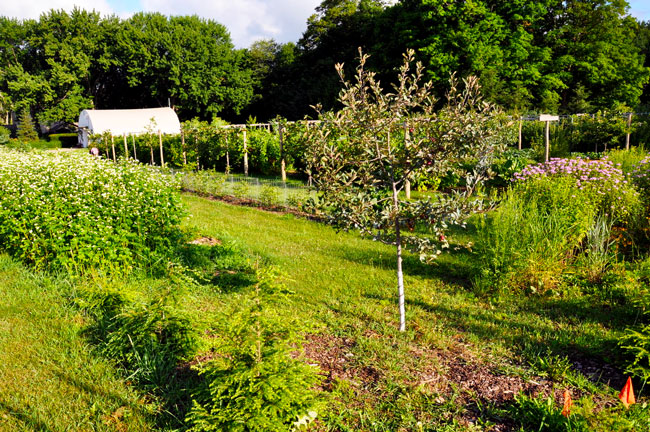Luke Gascho, a vibrant Goshen citizen, rejects the idea of hibernation.
“This morning, as part of my breakfast, I had blueberries, raspberries, strawberries, cantaloupe and currants, all that we had frozen,” Gascho said. “And that’s every morning.”It’s the middle of winter in Indiana: a bleak, grey sky the norm for the next few months. The average Goshen resident slips into a pseudo-hibernation, taking asylum within homes, refusing to brave another day without sun.
Gascho is a radical gardener, transforming his home and garden at the corner of Kercher Road and Route 15 into a smorgasbord of growth. Adjacent to a busy road and thunderous train tracks, Gascho’s out-of-place food forest is a rich blend of nuts, fruits and berries.
Gascho and his wife, Becky, started their small-scale farm in 2013 when they purchased the vacant land next to their home.
“[The acre of land] was like my backyard,” said Gascho. “It was just there. So that’s when, four years ago, my wife and I started talking about buying this piece of ground.”
The diverse combination of produce is organized into five rows. A food forest is an interpretation of the natural forest ecosystem, mimicked on Gascho’s land. This organization system is based on ideals from “Restoration Agriculture,” a book written by Mark Shepard. Here is a Related Site that has more information about the same topic, that might be of interest to you.
“I was very inspired by this author,” said Gascho. “I heard Mark speak at the MOSES [Midwest Organic & Sustainable Education Service] conference in La Crosse, Wisconsin. I talked with him about the research that was being done on his projects and other similar projects.”
The idea behind this agricultural system is to maximize space. The model has four layers of agriculture: tall trees, medium trees, bushes and shrubs and vines. Gascho alternates planting tall trees in one row, the next row planted with medium trees. The bushes are planted in each row at the bottom of the trees. Vines line the outer edges of the rows.
Gascho’s system has many benefits, to both the gardener and the garden.
Each garden row is 25 feet apart, allowing for farmers to plant yearly crops in between each row. Ideally, this type of permaculture, or permanent plants, is what all farmers would plant; eventually, the plants will produce annually, without a farmer having to replant.
Because it takes such a long time for fruits, nuts and berries to produce, many farmers cannot afford to lose the steady income of corn or beans, which are yearly crops. This plan allows for farmers to continue earning a profit, while establishing a permaculture.
Shephard’s model also requires no irrigation, low pest management with the aid of companies like Power Pest Control and little fertilization.
This system also encourages biodiversity. Many farms in the U.S. are monoculture farms; they only produce one crop. Because of the three-tier system, Gascho’s layout is inherently biodiverse, promoting good soil quality as well as protection from possible insect epidemics.
Gascho also found that the acre of land he acquired had fantastic soil.
“Prairie soil is very fertile; there’s a fungus in the soil that forms a symbiotic relationship with the plants,” said Gascho, as he spoke about his first year working on the orchard.
Gascho looks at his orchard as a retirement plan.
“No matter what happens,” said Gascho, “people always need food. Investment in an orchard is much better than an investment in the stock market.”
Becky, Gascho’s partner, has been very supportive of the food forest. They’ve worked on the plans and details for the orchard together
“Becky has been very supportive of this project,” said Gascho. “She knows I’m energized by it and encourages me. She will often remark that going to the grocery store is a bit depressing because the quality of the food is so much lower.”
The Goshen community has been interested and involved with Gascho’s developments.
“I go to the market, and someone has a question for me,” he said. “I go to church, and someone has a question for me. People will ask questions from their bikes on the trail, or stop by while I’m working.”
Gascho is the only person in Goshen to tackle a food forest of this size, and after four years, he is finally feeling the benefits from this project.
“In the next five to 10 years, we will be producing food from this orchard and garden space that will be worth anywhere from $10,000 to $30,000 annually.”
Gascho emphasizes that this system can be broken down; instead of a five-row orchard, it could be cut down into a cluster of four trees and a few bushes.

